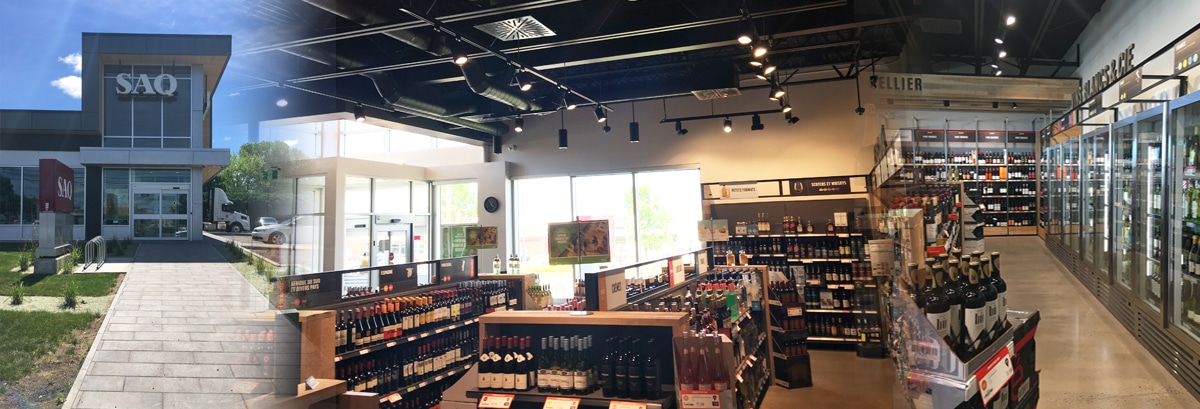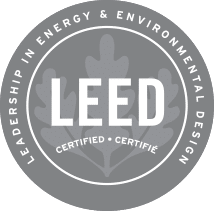SAQ Saint-Apollinaire
Saint-Apollinaire, Quebec
May 17, 2018
- Rating System/Standard
- LEED v4
- Certification Level
- Silver
- Building Type
- Retail
The Société des alcools du Québec (SAQ) has a strong track record of green building leadership. The government corporation’s store in Saint-Apollinaire builds upon this trend as Quebec’s first non-residential project to certify under the LEED v4 rating system, and the organization’s 35th LEED certification overall. The 265 m2 (2,825 sq. ft.) store received LEED ID+C: Retail Silver certification in May 2018, showcasing efforts to realize significant savings in energy and water consumption, and implement green building practices in design, construction, operation and management.
We spoke with Julie Hardy, senior project manager at Vertima, the company that served as LEED consultant on the project, about how the pursuit of LEED certification fits within SAQ’s overarching strategy and shares some of the innovative solutions the corporation has implemented to optimize building operations and reduce environmental impact.
Case Study Team
- Architect
- Atelier D Architecture – Architecture et Design Laflamme
- LEED Consultant
- Vertima
- Mechanical Engineer
- Génécor Experts-Conseils Inc.
- Electrical Engineer
- Génécor Experts-Conseils Inc.
- Structural Engineer
- Laplante Saucier Groupe Conseil
- Project Manager
- SAQ
- Contractor/Builder
- Kamco Construction
- Commissioning Authority
- Akonovia
- CaGBC members involved with this project
- Vertima
Leveraging LEED to achieve overall energy cost savings of 22.5%
SAQ has set an objective to pursue LEED certification for all new interior fit-outs of its buildings, and more than 30 of its stores have achieved this under the LEED Canada for Commercial Interiors 1.0 rating system. With the introduction of LEED v4, SAQ launched a pilot project to evaluate the feasibility and costs of the new rating system requirements, and the Saint-Apollinaire location is the first project to earn LEED v4 ID+C certification as part of this pilot.
The organization is already seeing strong savings as a result of this process: overall, the project has achieved energy cost savings of 22.5 per cent in comparison to ASHRAE 90.1-2010 due to the installation of highly energy-efficient air-to-air heat pump rooftop units and a heat recovery wheel to the base building. The lighting system design specified by SAQ made extensive use of LED fixtures in the retail area, cutting energy consumption by 50 per cent compared to ASHRAE 90.1-2010. The project also utilized low-flow fixtures to achieve a 38 per cent reduction in indoor water use. In addition, enhanced commissioning activities were completed to ensure that the building systems operate optimally, to support the operation of the building and verify that the energy conservation measures translate into real cost savings.
“SAQ is constantly researching the best sustainable development practices to adopt and continue to look for innovative ways to reduce their environmental impact, such as a commitment to reducing greenhouse gas emissions, obtaining green building certification for the branches and even looking at offering a wide selection of organic wines,” notes Hardy.
A province-wide network of innovative retail stores
Environmental performance and implementing sustainable practices are key priorities for SAQ, and as such it favours the following features throughout its store network and all of its administrative buildings:
- sound management of residual materials;
- recycled-content materials and FSC-certified wood;
- materials, floor finishes, paints and adhesives with a low level of harmful emissions;
- energy-efficient equipment; and
- the installation of concrete floors that integrate glass powder and aggregates from recovered bottles as a replacement for cement and limestone aggregates.
With this in mind, SAQ chose the LEED rating system for its commercial spaces to ensure a means for verification and confirmation that green building strategies are integrated into the design and construction of all its locations. “The SAQ will continue to propose and recommend LEED certification for its branches,” says Hardy.
She notes that some of the green building measures incorporated into the design of the Saint-Apollinaire store are now commonplace among other SAQ projects, such as the use of low-flow plumbing fixtures, FSC lumber and waste management practices. However, she adds that achieving the LEED v4 target did require SAQ to expand the range of sustainable solutions applied and to rethink its approach in specifying green construction materials.

An enhanced environment for both shoppers and employees
For the SAQ, it’s also important to take health and wellness considerations into account for its buildings. “Healthy indoor air quality is a priority for employees and clients at SAQ, for the well-being of the employees and to enhance the shopping experience,” Hardy says.
As such, the design requirements for the corporation’s branches specify increased ventilation, CO2 sensors and low-emitting construction materials. SAQ has also implemented a green cleaning policy that requires all branches to use non-toxic products in order to maintain healthy indoor air during operations.
In addition, stores are equipped with high-quality LED lighting fixtures with motion detectors that provide excellent energy savings and a well-lit environment, while reducing the amount of maintenance work needed.
Hardy adds: “Every day, SAQ takes concrete actions related to the social, environmental and economic challenges facing Quebec. Because beyond the commercial mission, SAQ is keen on making a positive difference to the community.”

LEED SCORE CARD
| Certification Level | Rating System | Total Points earned |
|---|---|---|
| Silver | LEED v4 for Interior Design and Construction: Retail | 52 |
0 out of 2
Integrative Process
2 out of 36
Location & Transportation
7 out of 12
Water Efficiency
28 out of 38
Energy & Atmosphere
4 out of 14
Materials & Resources
5 out of 16
Indoor Environmental Quality
2 out of 6
Innovation
4 out of 4
Regional Priority
